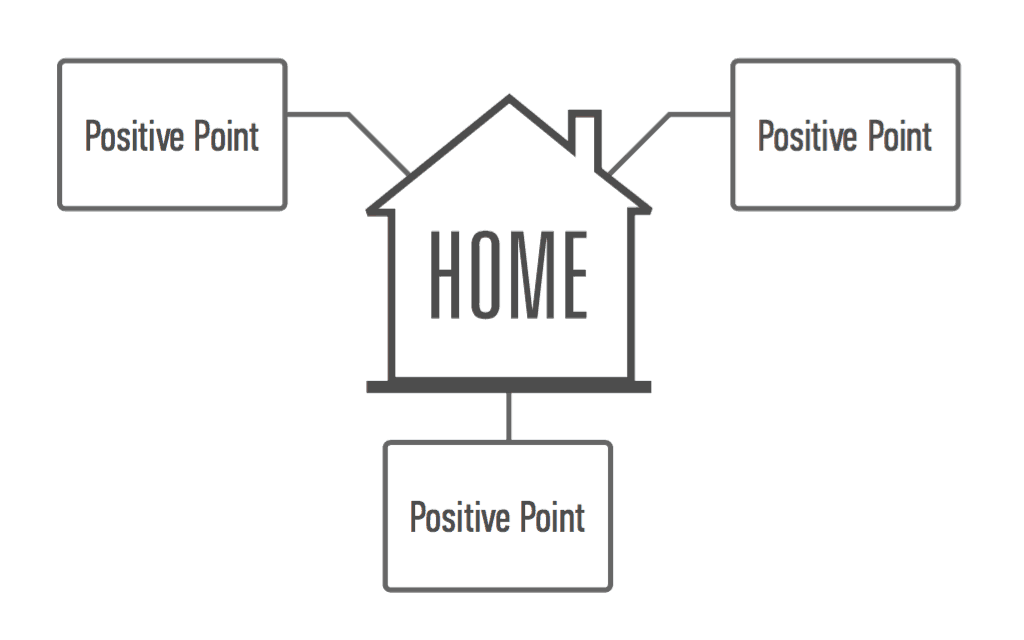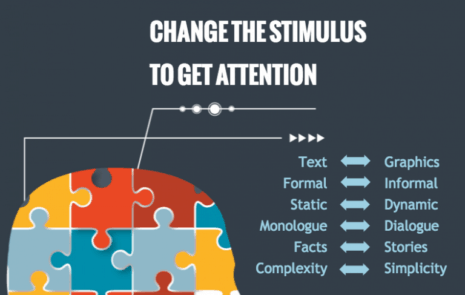
Bring Your Message Home to Audiences
An interview with Tripp Frohlichstein, co-inventor of the Message Map
Marketers, what’s your single most important point to communicate?
It’s crucial that you get one main point across to your customers. To make your message effective in the eyes of this audience, focus on one main message.
Avoid confusing customers with multiple main messages! Your audiences’ brains only take in one main message at a time. So make it your very best.
When you use Message Maps to create stories, the heart of your marketing message is called home base. It’s shaped like a home and placed at the center of your 1-PageTM Message Map.
For some companies, the home base message is the hardest thing that marketing creates. Naturally, that leads to some key questions about home base.

What is a home base message? What makes a home base great? Tripp Frohlichstein of MediaMasters, the co-creator of message maps, shared his thoughts.
“Home base is your single most important communication objective,” Frohlichstein says. “It tells your audience what you are about and what’s in it for them.
“So it answers the audience’s top question, What’s In It for Me? (WIIFM?)
“It also answers the question why you exist in terms of how you benefit your audience, as opposed to what you do or how you do it.
“Home base is simple. It is also honest. Don’t over-claim or people won’t believe you.
“Finally, make sure there’s an emotional impact to your home base. We all make decisions based on emotions. A good home base will stir those emotions, often providing more of a bond between you and your audience.
“The ideal home base appeals to virtually all audiences – customers, employees and investors. It’s important to have a home base, because home base makes it easier for people to grasp what you are all about, as well as remember you. This concept is supported by neuroscience.”
What’s the problem with using multiple main messages, as some experts advise?
“If you start sending multiple messages, people get confused as to what you are about. People will not be able to remember all your points,” Frohlichstein says.
“The problem is twofold. First, your audience really doesn’t know your central message – what is the ultimate impact you have on your audience? Is it improving the quality of life? Making life easier? Helping your company be more successful?
“Having a single message enables the audience to see why you do what you do to help them.
“The second reason to avoid too many messages (and too much information) comes from neuroscientist Dr. Carmen Simon, who says, ‘People don’t make decisions on what they forget.’ People decide based on what they remember. That’s so obvious, yet we forget it.”
What do great home base messages have in common?
“All of the best home base messages are simple. Simple sells. One of the most successful sales people I met offered this piece of wisdom, ‘Confused customers don’t write checks.’
“Great home base messages relate to what their audiences care about. One of the worst home bases I ever heard was a company whose message was, ‘We want to be a $5 billion company within 5 years.’ Who cares?
What are some great home base messages you see now?

“Currently, I think ‘Make America Great Again’ is a brilliant message. Whether you like Donald Trump or not, agree with him or not, you know what his message is. A high level, simple, four words. And he ties all of his talking points to that.
“So what does he say? We are going to build a wall and Make America Great Again. We are going to ban Muslims from coming into the country to Make America Great Again. We are going to renegotiate deals with China to Make America Great Again. Notice how almost everything he says relates back to his home base.
“To be clear, this should not be seen as an endorsement for Donald Trump — just his communication skills,” Frohlichstein adds.
“Another very effective message comes from the St. Louis United Way. When the rest of the country was using the confusing message (with no WIIFM) ‘Live United,’ St. Louis’ chapter used a more effective message, ‘Helping people.’
“It’s simple and easy to understand, yet very effective, as the St. Louis United Way is at the top when it comes to collecting donations (on a per capita basis). I’m not even sure what ‘Live United’ even means, but helping people is personal and emotional.
“The biggest benefit of United Way’s home base is that people now know what the organization really does. Before this messaging, when asked in focus groups about what they know about the United Way, people were confused. They provided a variety of answers and talked about pieces of the organization like collecting money for agencies, but not much beyond that. Now, when asked what they know about the United Way in focus groups, they almost universally answer, ‘They’re about helping people.’

“Another great home base came from the University of Missouri Outreach and Extension program. They needed a message to lobby the state legislature after being told their budget would be cut. The home base for the legislature was ‘Improving lives for the people of Missouri.’
“Fifty university people were trained to use the message map. With a message map that supported the home base with specifics on programs, the lobbying worked. The Outreach and Extension Program was able to reduce the cuts threatened.
“Similarly, a cooperative of electric companies used a message map to lobby Congress for funds to modernize the electric grid. With the right home base and supporting positive points, electric companies argued, ‘It is vital to our way of life.’
“Another example: for years, Tellabs (since taken private), used effective corporate messaging in the B2B space by simply saying to telecom customers, ‘We help you succeed.’
“If I am a business, that is what I want – success – so it may be stating the obvious. But if you don’t, your audience may think something way different about your motives. A home base literally can change the way people look at you.
“Edward Jones, the nationwide investment firm, has a home base of ‘Making a difference in people’s lives.’ What makes this special is that Edward Jones emphasizes this home base not only to external audiences, but also to internal audiences.
“Ideally, all companies should take this approach as every employee is an ambassador for your organization.
“Home base for a school district is: ‘Preparing kids to be successful in life.’ This is a distinct message, compared with many school districts who say their message is a good education.
“Education is what schools do. Instead of answering what, answer the question why is it important to provide a good education? To help kids be successful. That makes a lot more sense and it’s more emotional.
“Home base can even help you get your next job or promotion. A person may have many skills, but having a home base tells an interviewer how you benefit your potential employer. Home base might be, ‘I can contribute a great deal to help your company grow.’ Then, lay out your skills and relate it back to how the company might grow.”
Why are these home base messages so successful?
“First, they’re memorable. Second, they tell me, What’s In It For Me (WIIFM)? Third, they are usually very high-level, so a good home base is the common theme for all aspects of your organization.”
Does it matter if your home base is the same as another company’s?
“No. While a unique home base is nice, it is rare. In fact, you will often share your home base with other organizations. The difference between you and the other organizations is what and how you accomplish that home base.
“One example of different organizations that share the same home base is the St. Louis United Way and the Red Cross. Both have a home base of ‘helping people,’ but how they do it is very different. The United Way gives money to organizations to help people in a variety of circumstances. The Red Cross helps people differently by showing up at disasters and providing various forms of relief.
“Organizations may share a home base but support it with different positive points. So two telecom companies might have a home base of ‘Making customers’ lives easier.’ One company might stress its network to achieve that goal while another might say it’s the variety of easy-to-use smartphones they offer. Both can make a legitimate argument about how those features relate to the home base.”
Why is it important to repeat your home base? What happens when you don’t?
“There are a couple of key reasons to repeat your home base.
“First, if you say it once, it might not even be heard as your listeners’ minds wander. But even if it is heard, along with everything else you say, it may not stand out if you only say it once.
“Repeating it makes sure your home base is heard. Repetition adds importance to your home base. That said, home base should be used properly. Repeat it only when it’s relevant.
“If you ever begin to answer a question thinking, ‘How the heck am I supposed to get to my home base?’, don’t even try. Just answer the question.
“The best home bases are co-created by a group of people from various levels of an organization – to get the widest view as well as buy-in. If people own the idea of home base, they will often take responsibility to make sure the home base message is used.”
Learn more about 1-Page Message Maps here.
Related Posts
Spread your message to succeed
A client in a workshop asked, “Once you co-create your Message Map, what to do next?” Delivering the right message for your brand is...
What You Taught Me About Content Marketing: Boil It Down!
Lessons about content marketing. As I analyze the content you shared most on social media over the past year, I’m learning a lot from...
What content must do to hold audiences’ attention
It’s hard for content marketing to hold audiences’ attention. Estimates say 90% of the content that people consume is soon forgotten. The real question...
How Does A B2B Company Start Content Marketing?
Start where you are. Adopt the right mindset: See the world through the eyes of buyers. Each company has different assets and strengths that...





